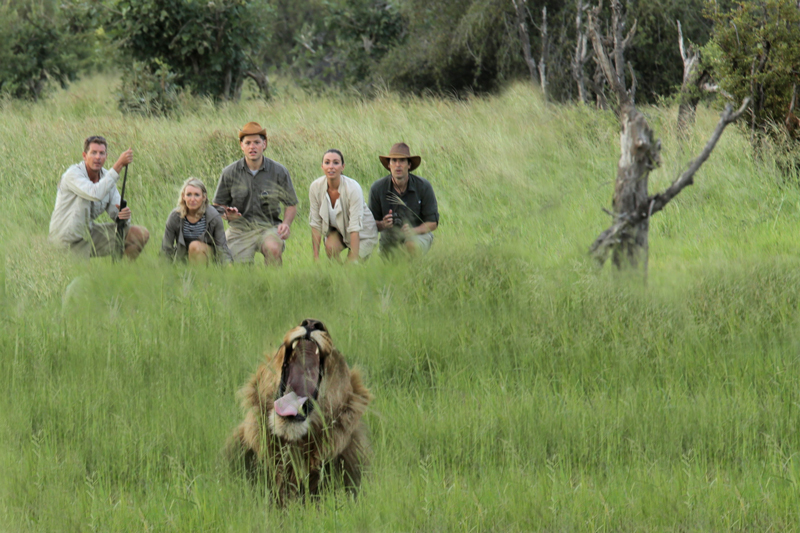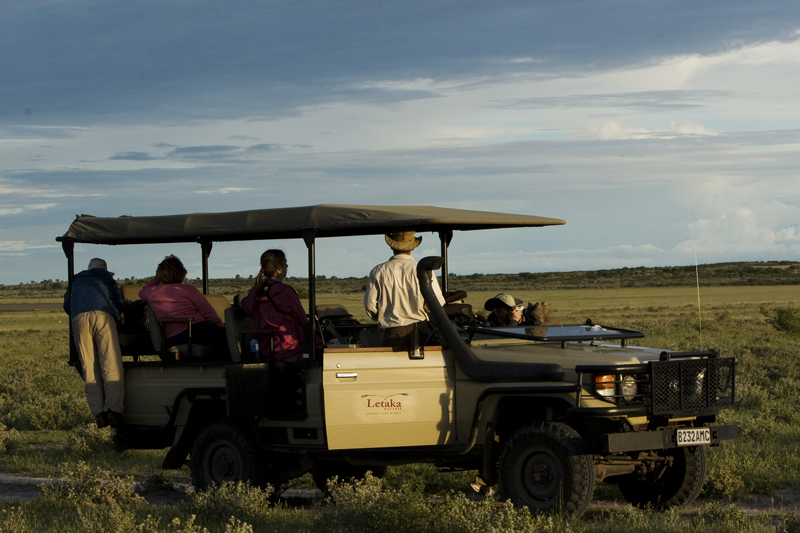Letaka Private Mobile Safaris
Letaka Safaris offer private mobile safaris throughout Moremi, Mababe, Savuti, Chobe, CKGR, Nxai and Makgadikgadi.
Letaka Safaris is a family owned company run by brothers, Grant and Brent Reed. They are highly experienced and fully qualified guides, and have a deep passion for the bush with particular interests in snakes, birding and walking. The brothers have been involved in guide training over many years, both for their own employed guides and with the Okavango Guiding School which they created to elevate the standard of guiding in the country. Letaka run a number of scheduled group departures, but we tend to recommend private safaris where possible. For groups of four guests or more they offer great value for money, though for two guests on a private basis it is naturally expensive.
Letaka do not try and provide the most luxurious mobile safari possible. Their ethos is all about the safari experience and guiding, though they do still provide lovely food, friendly service and a very professional operation.
We highly recommend private mobile safaris for two main reasons. Firstly, they offer a little bit of adventure and a wonderful close to nature wilderness experience. Many of the best ‘bush stories’ originate from camping out in the bush and there is something simplistic about spending time in a small, low impact camp in the heart of the wilderness. Whether it is using torches to keep an eye on skulking hyaena in the darkness, having dinner interrupted by hippo coming out of a lagoon to graze, or falling asleep to the sound of roaring of lions, sleeping out in the bush is a magical experience provided you do not feel the need for more substantial accommodation arrangements.
Secondly, you are able to enjoy a private camp experience with expert guiding. Private mobile safaris are invariably led by passionate and knowledgeable guides, and you have them all to yourselves. You can also to a large degree set your own schedule, giving you the flexibility to have early or late starts, and to stay out game-viewing for as long as you need. You are not bound by the constraints of a well organised lodge safari and this will appeal greatly to some travellers.
Rooms
Camps consists of accommodation tents (approximately 9 x 15 foot with ample standing room, beds with mattresses, gauze windows and bed side tables), a camp fire area and dining tent. To the rear of each tent there is an open en suite bathroom enclosure containing a short drop toilet (with a throne seat) and a ‘bucket’ shower – cold, warm or hot showers can be taken once a day. To the front of each tent is a verandah with two comfy safari chairs and a washstand. The camps are set up in the exclusive HATAB camping sites, and all camp chores are undertaken by the friendly safari crew.
Central Areas
Delicious meals are served either in the simple mess tent (dining table and chairs provided) or under the stars around the camp fire.
Facilities
Wi-Fi – No
Power for charging – No
Swimming pool – No
Habitat & Wildlife
Letaka operate throughout Northern Botswana and can provided mobile camps in Moremi, Mababe, Savuti, Chobe, CKGR, Nxai and Makgadikgadi.
About half the Okavango Delta region is made up of the gazetted Moremi Game Reserve which includes Chiefs Island. The Moremi is one of the most beautiful game reserves in southern Africa – an area of mopane woodland interlaced with giant fig and knobthorn trees, open vleis and river courses. Animals commonly seen in the area include elephant, lion, leopard, lechwe, wild dog, tsessebe, impala, reedbuck, zebra, giraffe, wildebeest, genet, civet and serval, and many of the smaller mammal species. The birdlife of the region is equally spectacular. White rhino were re-introduced to Chiefs Island a few years ago and can sometimes be seen in Moremi.
To the east of Moremi, at the eastern extreme of the Khwai River, the Mababe Private Reserve offers excellent game viewing as well as the chance to undertake walking safaris and night drives. With a broader range of activities and being a natural stopping off point on the journey from Moremi to Savuti (or vice versa), Mababe is worth including in most mobile safaris through northern Botswana.
The Chobe covers an area of 11,000 sq. kms and its habitats range from the floodplain and backwaters of the river to sand ridges, dry lake beds, riverine thickets/bush and mopane forest. The Chobe stretches south-westwards from Kasane and the river in the north, to the Mababe Depression (a dead lake area fed by the Savuti Channel). Except for the network of roads and one lodge along the river and three in the Savuti, there is little development within the park. Most travellers to the Chobe concentrate either along the river frontage, or in the Savuti area. Travellers using mobile tented camps may have the option to move away from these busier areas.
The birdlife is prolific – kingfishers, bee-eaters, the majestic fish eagle, martial eagle, ducks, egrets, plovers, herons, cranes, storks, geese, woodpeckers, shrikes, thrushes, buntings, chats and owls are just a few of the many species found here. However, Chobe is famous for its large animal herds, particularly elephant and buffalo which frequent the river courses, where hippo laze all day, to quench their thirst. Amongst the 16 antelope species present in Chobe, kudu are common, and the near endemic puku can also be seen. The Chobe bushbuck is a sub-species of bushbuck found only here. Giraffe, lion, leopard, waterbuck, mongoose, tsessebe, roan and sable antelope, lechwe, impala, warthog, wild dog, hyaena, baboon and vervet monkeys are among the other animals to be seen.
The Central Kalahari is an area of semi-desert, where trees, bushes and grass do exist within an otherwise hostile desert environment. This allows a variety of birds and animals to exist in the region, including the rare brown hyaena, lion, cheetah, leopard, wild dog, giraffe, oryx, red hartebeest, eland, kudu, wildebeest, springbok, steenbok, black-backed jackal, meerkat, ostrich and a variety of smaller game including the nocturnal species such as aardwolf, honey badger, bat-eared foxes, serval, caracal, porcupine, African wild cat and genet. The region is best visited during the ‘green’ season from November to March/April, when game concentrates on the various open ‘pans’ within the reserve. During the dry season, the landscape is harsher and game is more spread out throughout the reserve (especially the late dry season from August to October). However recently introduced ‘pumped’ waterholes will become focal drinking spots during these drier months, and should improve game viewing.
Nxai Pan National Park lies just north of the Maun-Nata road and adjoins the northern border of the Makgadikgadi Pans National Park. Originally state land, an area of 1676 sq.km. of Nxai was declared a game reserve in 1970. In 1992 the boundaries were extended to include Baines Baobabs to give the present total area of 2578 sq.km. and National Park status was granted.
The Nxai were once part of the great lake that covered central Botswana which also included The Okavango Delta, Makgadikgadi and Lake Ngami to name a few. In 1861, the famous painter Thomas Baines arrived to paint an unusual group of baobab trees – one of which lies on its side. This beautiful group of trees became known as ‘Baines Baobabs’ and they can be seen on the southern side of the park.
The Pan itself is a fossil lakebed about 40 sq.km. in size. The landscape is largely covered by grassland, and dotted with clusters of umbrella acacia trees and mopane woodland towards the north. During the rains from November to April, the pans become covered in grass which is a landscape very similar to the Kalahari. Nxai is well known for its huge springbok population and once the rains have started, giraffe, gemsbok, elephant, eland, greater kudu, red hartebeest and zebra also migrate to the region. The zebra come in their thousands to drop their young, and the giraffe congregate to form large groups. The birdlife too is excellent with a large number of raptors in particular. The large herds of herbivores attract all the major predators including lion, cheetah, spotted hyaena, wild dog, leopard and jackal. Brown hyena and large numbers of bat-eared fox can also be seen.
During the dry season some species move out to other areas, in particular the zebra herds and a high proportion of the elephants, but a ‘pumped’ waterhole supports the resident game and so there is good game viewing all year round.
Activities
In Moremi Game Reserve and other National Parks activities are limited primarily to game drives by day. However, other activities (often third party) can be built into your itinerary, both in Moremi and further afield. In both Moremi and Chobe boat cruises can be included, whilst in Mababe it is possible to include guided walks (subject to your safari being hosted by a suitably qualified guide) and night drives.
Seasons
Whilst mobile safaris in Botswana are possible year round, Letaka tend to favour March through to November, avoiding operating during the wettest months. Game viewing in the Moremi Game Reserve and other key wildlife regions is best between June and early November
A private mobile safari is a brilliant option for families provided that you are up for an adventure and your children are old enough to enjoy the close to nature experience. Letaka accepts children from six years of age on private mobiles (parents can ‘split’ for accommodation if needed or two tents can be connected to an adjoining bathroom), though we would suggest 12 years and older is more suitable for the rigours of a mobile adventure. They have a 12 years + requirement on their scheduled departures.
Letaka support Travel for Impact who put funds from tourism back into the communities. Letaka give two seats on one of their trips to Travel for Impact who then sell the seats and use the proceeds to give back to the local communities.
They also promote San Art by again selling safari seats with the proceeds going to this particular community development. They also helped to raise funds to send two San artists to the US to promote their artwork.
Each year Letaka take a group of school children to the bush for the day enabling them to experience the wildlife and their natural heritage. They call this Cheetahs for Conservation, and whilst they may not always get to see cheetah, they do get an understanding of how special their animals are.
Letaka operate the Okavango Guiding School where they run a ‘sponsor a student/guide’ scheme which sees guests learn bush skills and how to become a guide. Part of their fees for this experience then go towards the sponsorship of a trainee guide who otherwise would not be able to become a professional guide due to the funding involved in the training.
Letaka attend the British Bird Fair each year and here they also give two seats on one of their safaris to the auction and raise funds for the RSPB.

























